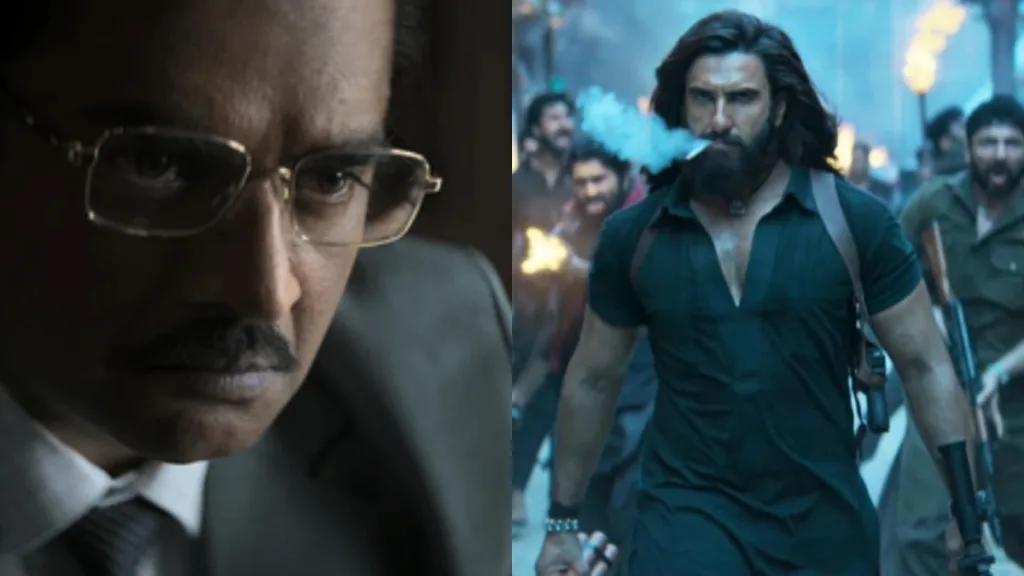When the first poster for R Dhurandhar arrived online, fans hardly recognised R Madhavan. Instead, they spotted something else entirely—a figure reminiscent of India’s national security machinery. Seated on a couch in a dark suit, chin in hand, his gaze sharp, the caption “Charioteer of Karma” floated over the image. And the comments? They ranged from “Ajit Doval look-alike” to comparisons with Ranveer Singh and Aditya Dhar. The visual departure is bold—and in today’s image-intensive industry, hard to miss.
The poster sets the tone for what promises to be an intense and stylised world: Dhurandhar, directed by Aditya Dhar and starring Ranveer Singh, R. Madhavan, Arjun Rampal, Akshaye Khanna and Sanjay Dutt, is being positioned as a dark, action-driven thriller. The production credits—Jio Studios and B62 Studios—further elevate expectations. Release date is set for 5 December 2025, with the trailer scheduled for 12 November.
R Madhavan’s transformation is remarkable. His usual warm-eyed, affable on-screen presence has given way to a rigid, almost militarised persona. Fans quickly responded, remarking that his hair-cut, heavy brow and sharp glance resemble India’s National Security Advisor Ajit Doval. Some pointed out a visual similarity to Ranveer Singh’s own gritty looks or to Aditya Dhar’s trademark style of intense characters. One fan commented: “Haven’t been excited for any film this year except this one.”
R Madhavan’s shift in career
The shift is more than cosmetic. R Madhavan’s established career—from romantic leads to seasoned character roles—has afforded him versatility. But here, the image demands a different energy. He isn’t merely an actor in a suit; he is embodying a mood-signature: gravity, authority, and menace wrapped in controlled calm. His pose—leaning in, finger resting on cheek—invites intrigue: What’s he plotting? Where does the karma come into play? What is the “chariot” he is driving?
For the industry, this kind of look is strategic. In the streaming and theatrical ecosystem, first-look posters serve as brand-packaging moments. They hint at tone, character arc, world-building—and they test fan reception long before release. Madhavan’s makeover signals a deliberate pivot from his known persona, engaging audiences afresh. The comparisons it generated are part of that buzz. Within hours of the reveal, social-media feeds lit up. The poster became a thesis on transformation: actor meets character meets spectacle.
Yet, the resemblance to a real-world figure like Ajit Doval may also raise eyebrows. The borrowing of aesthetic cues from actual security-state iconography isn’t new in cinema, but it reflects how Indian film increasingly plays with visual authority. Politico-visual references—whether subtle or overt—help anchor high-stakes thrillers in familiar registers of power. In Madhavan’s case, the “look” acts as a shorthand: he is no longer just a star—he is an enforcer of fate.
At the same time, the reaction suggests that fans enjoy spotting connections. The moment of recognition—the “Oh, that’s like Doval! That’s Ranveer’s jagged edge! That’s Dhar’s style!”—becomes part of the engagement. It’s not just about the film; it’s about mapping the image onto known personalities, known aesthetics. In that sense, the poster serves dual purpose: it introduces a character, and it invites a visual game of “who are you remaking?”
But how does Madhavan navigate this under his long career? For an actor who has previously played humane, accessible characters, this shift is risk and reward in equal measure. The risk: alienating fans who loved his familiar self. The reward: breaking out into new territory, generating curiosity, refreshing his brand. Given the industry’s appetite for reinvention, this may well be his statement that he isn’t boxed in.
The supporting cast adds further dimension. Ranveer’s involvement already primes audiences for intensity; alongside Madhavan, the film gestures at generational spans—stars with charisma shaping the framework of story, world and conflict. The idea of “karma” in the caption further deepens the theme: it isn’t just action for action’s sake—it’s moral weight.
As the trailer date looms, viewers will watch not just the storyline but the character packets introduced. Madhavan’s first look poster has done its job: it has disrupted expectation, generated buzz and seeded questions. From his suit to his gaze to the fans latching onto “Ajit Doval likeness,” everything plays into a marketing moment. More than that, it underscores how first-looks today are visual events—short-hand narratives that tell us who the character is before the story unfolds.
In summary, R. Madhavan’s new avatar in Dhurandhar is a masterclass in transformation. He steps away from the familiar, embraces an austere energy and allows his image to carry uncertainty and intrigue. The internet’s immediate reaction—comparing him to security-state figures and edgy contemporaries—illustrates that the audience not only consumes the poster, but dissects it. The artist becomes an icon becomes a reference.
Whether the film succeeds or not, that shift in image may stay. Because in today’s cinematic economy, reinvention after decades isn’t just recommended—it’s necessary. And Madhavan seems willing.

